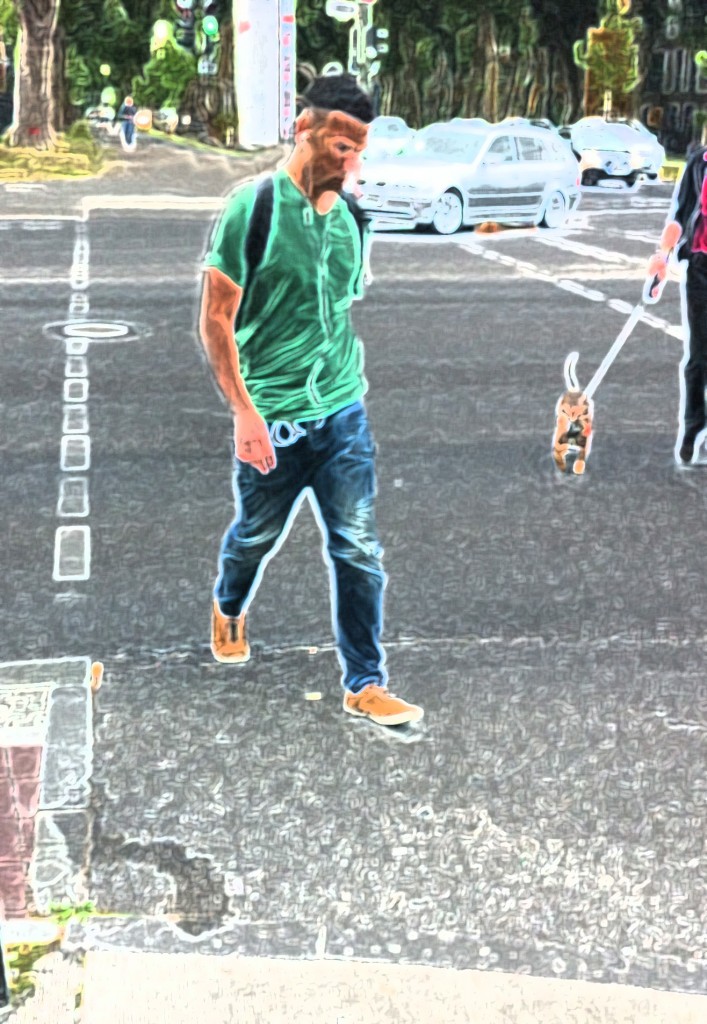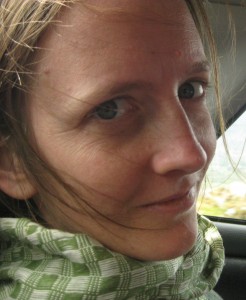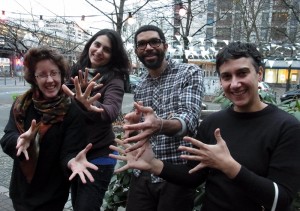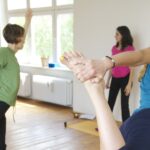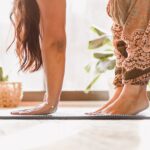Berlin is a city of cyclists. The combination of a well developed bike lane infrastructure, wide streets, relatively little traffic and very few hills is a hard one to beat. Perhaps the only drawback to cycling in this great city is the winter—it can get grey, wet, cold and generally miserable. But, as long-time Berliners will tell you, cycling through the winter is a great tool for keeping fit and fighting the seasonal depression that plagues the city from January till April.
We teach yoga in English, so we meet a lot of newcomers to Berlin, and we can tell you that, even if you weren’t a cyclist at home, you’ll probably become one in Berlin! And we think that riding your bike is a meditation style all its own. (Bonus points for singing as you ride.) Because we teach yoga in Berlin, we often end up teaching yoga for cyclists—yoga poses can really help ease sore muscles, lengthen tense calves and hamstrings, strengthen your back, increase lung capacity and generally get your body in shape for biking. Yoga asana are a great complementary practice for city and long distance cyclists.
In this blog post, we’d like to introduce some of our favourite yoga poses for cyclists. Yoga benefits your muscles, your breathing, your endurance and your concentration. It also relaxes you and helps you enjoy your life. We hope these yoga asana help you relish cycling in Berlin even more, and that they provide you with an opportunity to enjoy yoga in daily life.
These postures can be gentle yoga or more advanced yoga—you choose how long and how deep you want the stretch to go. They are also appropriate as yoga for beginners—just move slowly, breathe deeply and practice regularly.
Reclining Big Toe Pose/Supta Panangusthasana
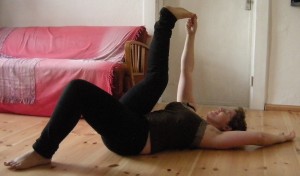
Tight hamstrings and calves are almost inevitable when you start cycling. As your muscles strengthen, they’ll probably also become much tighter. Tight hamstrings can pull your lower back out of alignment—and you don’t want to go there! But you can counter this with regular stretching. The safest way to stretch the backs of your legs is while lying on your back. Forward bends also stretch your hamstrings and calves, but most people with tight legs end up bending from their waist, and this stresses the lower back. It’s safer to start from the ground, and only progress into forward bends if you’re sure you have a strong core, no disc injuries and relatively long hamstring and calf muscles.
Simply lie on your back and extend one of your legs up towards the ceiling. You can keep the other leg lying flat, or you can bring the foot to the ground and bend the knee. With your raised leg, you can either point the toe to stretch the hamstring, or flatten your foot and press through your heel to stretch the calf. You can reach towards your big toe with the arm of the same side, if you like—that’s where the name of the pose comes from—but this takes a fair bit of flexibility. Just holding the leg there will be plenty for most people! Hold it for 1 to 3 minutes, and breathe deeply.
Kneeling Crescent Moon/Anjaneyasana
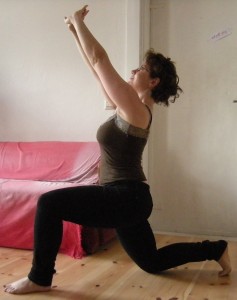 Aaaah, tight hip flexors. A sure sign of time spent sitting—in a chair, or on your bike. Every time you pull your foot up and over the pedal, you’re using your hip flexor. If they get too tight, especially in combination with tight hamstrings and weak abdominals, they’ll contribute to lower back pain. But never fear! You just gotta lunge.
Aaaah, tight hip flexors. A sure sign of time spent sitting—in a chair, or on your bike. Every time you pull your foot up and over the pedal, you’re using your hip flexor. If they get too tight, especially in combination with tight hamstrings and weak abdominals, they’ll contribute to lower back pain. But never fear! You just gotta lunge.
Start kneeling. Tip your pelvis so that your public bones are flush with your hips. (You can practice this against a wall to get the feeling of it. You want to feel your pubis and your hips both pressing forward.) Place your right foot forward, with the thigh parallel to the floor and the knee bent just over the ankle (not beyond). You can put something underneath your left knee if it feels sore. From here, engage your lower belly and draw your torso upwards, towards the ceiling. You’ll soon feel a pulling in the front of the left hip. That’s your hip flexor. Stay for 5-7 deep, long breaths, and then repeat on the other side.
Downward Facing Dog/Adhomukhasvanasana
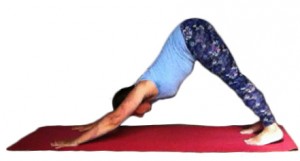 Whether you’re sitting up or bending forward on your bike, you’re going to need to have a strong back. That means strong shoulders (this also helps protect you in case of accidents: if they’re not strong, the shoulders dislocate more easily when you brace yourself during a fall or impact), strong paraspinals and—very importantly—strong abdominals. Downward Dog, when practiced correctly and regularly, will help you strengthen your whole spine and make it easier to ride without pain.
Whether you’re sitting up or bending forward on your bike, you’re going to need to have a strong back. That means strong shoulders (this also helps protect you in case of accidents: if they’re not strong, the shoulders dislocate more easily when you brace yourself during a fall or impact), strong paraspinals and—very importantly—strong abdominals. Downward Dog, when practiced correctly and regularly, will help you strengthen your whole spine and make it easier to ride without pain.
Start with your knees on the ground and your arms stretched forward. Lengthen and straighten your back by bringing your ears between your upper arms and lifting your bum into the air. Tuck your toes under to give yourself traction and then, slowly and using your lower belly, exhale and push your bum into the air. Keep your back straight and your arms long. You can leave your knees bent if straightening your legs compromises having a straight back. Draw your shoulders down and away from your ears, let your neck be long and keep breathing, whatever you do! The posture will get easier with time.
Eagle Arms/Garudasana arms
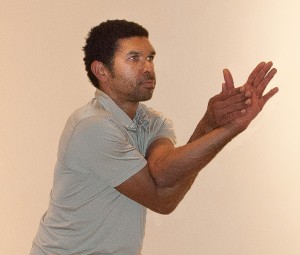 Holding onto your handlebars takes a lot of work in the arms and shoulders, especially if you’re cycling into the wind or uphill. Over time, cycling will help you to develop a stronger upper body. You can minimize pain and discomfort by taking the time to check your alignment on the bike and stretching your shoulders and neck before and after riding.
Holding onto your handlebars takes a lot of work in the arms and shoulders, especially if you’re cycling into the wind or uphill. Over time, cycling will help you to develop a stronger upper body. You can minimize pain and discomfort by taking the time to check your alignment on the bike and stretching your shoulders and neck before and after riding.
Sitting comfortably in a chair or on a block, gently bring your elbows, forearms and palms together in front of your chest. Bend your elbows and bring your hands roughly to the height of your gaze. Press the elbows and forearms together and breathe into the space between your shoulder blades. If you want to go further, place your left elbow over your right, and wrap your forearms around each other, bringing your right fingers or palm to the left hand. Drop the shoulders and gently lift the elbows, or make circles slowly with the arms. Don’t forget to breathe. Repeat on the other side.
English Yoga Berlin is a collective of yoga teachers offering yoga classes in Berlin. If you’re looking for yoga in Berlin, we offer community yoga: accessible, affordable and high quality vinyasa yoga, restorative yoga, classical yoga, hatha yoga and yoga nidra. See our yoga class schedule or find the location of our yoga Berlin Kreuzberg studio.





